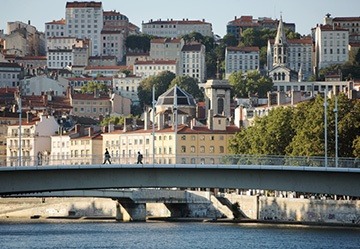Feasting in Lyon
Travel Stories: Jeffrey Tayler feared he would never feel as intoxicated with the sense of discovery as he once did. But something clicked when he set foot in France's third-largest city.
09.30.08 | 9:08 AM ET
 The more I travel, or maybe it’s just the longer I live, the more I find elusive the pleasure of novelty, the exhilaration of discovery. I most memorably experienced these feelings on a sunny but cool May morning in 1983, when I stepped off the train from Madrid, where I had been studying during my senior year of college, and walked out into Paris to spend a week. I carried with me little more than postcard notions of the city, but it did not disappoint, bringing to mind, of course, every sort of grandiloquent truism: historic grandeur, aesthetic splendor, romance and haute cuisine. Since then, more than two decades and some 60 countries later, I’ve often thought back on those days and recalled Rimbaud’s words about life, once, “long ago,” being a “feast” at which “all hearts were open,” “all the wines were flowing,” and despaired of ever again feeling so intoxicated with a new place, of tasting anew such bittersweet, yet revivifying, wine.
The more I travel, or maybe it’s just the longer I live, the more I find elusive the pleasure of novelty, the exhilaration of discovery. I most memorably experienced these feelings on a sunny but cool May morning in 1983, when I stepped off the train from Madrid, where I had been studying during my senior year of college, and walked out into Paris to spend a week. I carried with me little more than postcard notions of the city, but it did not disappoint, bringing to mind, of course, every sort of grandiloquent truism: historic grandeur, aesthetic splendor, romance and haute cuisine. Since then, more than two decades and some 60 countries later, I’ve often thought back on those days and recalled Rimbaud’s words about life, once, “long ago,” being a “feast” at which “all hearts were open,” “all the wines were flowing,” and despaired of ever again feeling so intoxicated with a new place, of tasting anew such bittersweet, yet revivifying, wine.
But recently in Lyon, riding on the open upper deck of a Grand Tour bus, I felt tipsy with discovery once more. Evening’s blue pallor was washing over shiny Citroens and Renaults that scooted around beneath us like giant bejeweled beetles. My bus, amid them, skirted place Bellecour, an expanse of raked beige pebbles dominated by an equestrian statue of Louis XIV, the Sun King, and glided down the smoothly paved streets of the Presqu’île (or “Peninsula,” as the commercial center is known) past the glittering gilt shop windows of Praho and Kenzo, Milano and JB Martin. We soon mounted the bridge to Vieux (Old) Lyon, crossing over the river Saône, near where the embankment curved west beneath the labyrinthine hilltop neighborhood of Croix Rousse, the longtime abode of silk weavers.
Above, by the twin belfries of a soaring white basilica atop Fourvière promontory, stood a floodlit golden statue of the Virgin Mary. My audio-tape guide told me that Roman invaders had initiated Lyon’s history up there, founding the military colony of Lugdunum after capturing, in 43 B.C., this part of France in the Gallic wars. But Vieux Lyon, with its mélange of burnt sienna and peach façades, recalls Florence—apt, since Lyon flourished during the Renaissance, following an influx of Italian bankers. It came as no surprise when the tape informed me that, in 1998, UNESCO had designated the arrondissements on both banks of the Saône a World Heritage site—the largest urban environs on Earth so designated, in fact.
An hour and a half later, after having wound up Fourvière’s switchbacks, passed by the basilica (the Notre Dame de Fourvière) and France’s oldest Roman theater, and rolled down to cross a bridge over Lyon’s second river, the Rhône, we pulled back into place Bellecour. I jumped off into the dreamy light, and joined the promenade of elegantly dressed Lyonnais heading toward the outdoor cafés near the Hôtel de Ville.
Though Lyon, with more than 400,000 people, is France’s third-largest city, it has never counted among its most popular tourist destinations. Partly this stems from its reputation as home to a plethora of polluting riverside factories. But also a certain Lyonnais reclusiveness—or bourgeois aloofness, many French would say—has been to blame. Wealthy from its banking, viticulture, printing and silk industries, Lyon, until the 1990s, preferred to repose in relative solitude, doing little to attract tourists.
“Lyon always relied on word-of-mouth advertising,” Blandine Thenet, the press attaché for the municipal Office of Tourism and Congresses, told me the day after my arrival. But, she explained, that changed in the 1990s, with the launching of a campaign to attract visitors, especially business tourists, and the enactment of Plan Rhône and Plan Bleu, development projects that aimed to revive the city’s rives gauches and rives droites, which had suffered damage from now-defunct factories. They succeeded. Tourism, mostly French, has been growing, and (for example) from 2004 to 2005, increased by 7 to 8 percent, bringing in revenues of a billion euros. Among the French, at least, for the first time, Lyon has become branché (cool) or, more colloquially, “in,” to use the English slang they often employ.